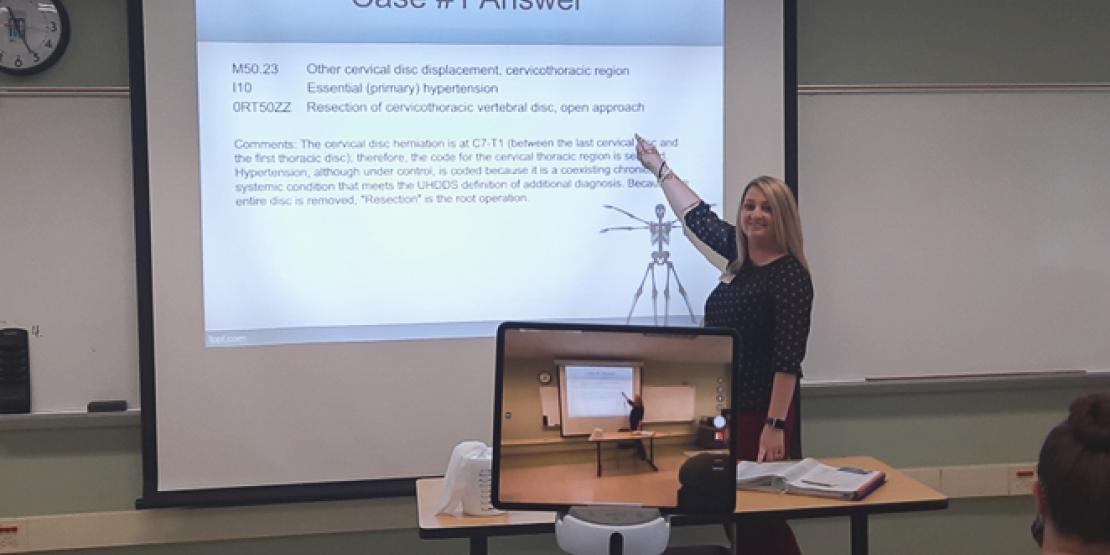What is a Synchronous Presentation? All You Need to Know
A synchronous presentation is a live, real-time presentation that allows participants to interact simultaneously through online platforms or in-person meetings. In these presentations, information is delivered and received instantly, enabling immediate feedback and engagement among attendees.
The presenter and the audience connect in real-time, facilitating a dynamic and interactive learning or sharing experience. Synchronous presentations are often utilized in virtual classrooms, webinars, online meetings, and conferences where active participation and collaboration are desired. With the increasing popularity of virtual communication tools, synchronous presentations offer a convenient and efficient way to convey information and foster meaningful connections among participants.
The Definition Of Synchronous Presentations
A synchronous presentation refers to a type of communication method that allows individuals to interact and participate in real-time. It involves the delivery of content, such as presentations, webinars, or meetings, where the presenter and the audience are connected simultaneously. This type of presentation typically occurs through online platforms or video conferencing tools, enabling participants to engage with each other in a virtual environment.
During a synchronous presentation, the presenter delivers information and engages with the audience in real time, allowing for immediate question-and-answer sessions, discussions, and collaboration. It offers a level of engagement and interactivity that can enhance the overall learning experience and foster a sense of connection among participants.
Key Characteristics of Synchronous Presentations
Synchronous presentations are a common form of communication where the presenter and the audience engage in real-time interaction. Unlike asynchronous presentations, which are pre-recorded and viewed at the audience’s convenience, synchronous presentations occur at a specific scheduled time. To gain a deeper understanding of synchronous presentations, let’s explore their key characteristics:
1. Real-Time Interaction: Synchronous presentations involve immediate interaction between the presenter and the audience. Both parties are present and engaged simultaneously, allowing for questions, comments, and discussions as the presentation unfolds.
2. Scheduled Timing: Synchronous presentations occur at a predetermined date and time. Participants must be available and present during the presentation to actively engage with the content and the speaker.
3. Live Communication: Presenters deliver their content live, addressing the audience in real time. This live aspect can create a sense of connection and engagement, as participants can respond to each other’s cues and reactions.
4. Two-Way Communication: Synchronous presentations facilitate two-way communication, enabling the audience to ask questions, seek clarification, and provide feedback during the presentation. This interactivity enhances engagement and learning.
5. Immediate Feedback: Both presenters and participants receive immediate feedback. Presenters can gauge the audience’s reactions and adjust their delivery accordingly, while participants can seek clarifications or express their opinions in real time.
6. In-Person or Virtual: Synchronous presentations can occur in physical settings, such as classrooms or conference rooms, where the presenter and the audience are physically present. They can also take place in virtual environments through webinars, video conferences, or live streaming platforms.
7. Presenter’s Presence: The presenter’s physical or virtual presence is a key component of synchronous presentations. Audiences can see and hear the speaker in real time, allowing for non-verbal cues and visual engagement.
8. Structured Timing: Synchronous presentations typically adhere to a structured timing format, with designated time slots for the presentation, Q&A sessions, and discussions. This structure ensures that the presentation stays on track and within the allocated time.
9. Immediate Engagement: Synchronous presentations often capture the audience’s attention from the start, as they know they can actively participate and engage with the content and the speaker immediately.
10. Collaboration and Networking: In addition to the presentation itself, synchronous settings provide opportunities for audience members to collaborate, network, and connect with each other. This social aspect can enhance the overall experience.
11. Time Zones and Accessibility: Organizers of synchronous presentations must consider participants’ time zones to ensure inclusivity. Adequate planning and scheduling are essential to accommodate diverse global audiences.
12. Technical Requirements: Participants and presenters may require specific technical tools and a stable internet connection to participate in virtual synchronous presentations. Ensuring technical readiness is crucial for a seamless experience.
Synchronous presentations Vs asynchronous presentations
Synchronous presentations differ from asynchronous presentations in terms of the timing and level of interaction. While synchronous presentations happen in real-time, asynchronous presentations do not require the presence of the presenter and participants at the same time.
In asynchronous presentations, the content is pre-recorded or provided in a format where participants can access it at their convenience. This allows them to consume the content at their own pace, without the need for immediate interaction or participation. Examples of asynchronous presentations include pre-recorded webinars, online tutorials, or video lectures.
On the other hand, synchronous presentations allow for instant communication and engagement between the presenter and the audience. This allows questions to be immediately answered, discussions to occur in real-time, and collaboration to take place seamlessly. Synchronous presentations are particularly beneficial when collaboration, active participation, and immediate feedback are desirable elements of the presentation or learning experience.
In summary, synchronous presentations are real-time communication methods that enable presenter-audience interaction, while asynchronous presentations are pre-recorded or pre-planned content that can be accessed at any time.
Benefits Of Synchronous Presentations
Synchronous presentations, also known as real-time presentations, offer a range of benefits that can enhance your communication and collaboration efforts. These presentations involve delivering content to an audience in real time, allowing for immediate interaction and engagement. In this article, we will explore the advantages of real-time communication in presentations, increased engagement and interaction, and the collaborative opportunities that synchronous presentations present.
Advantages of real-time communication in presentations
Real-time communication in presentations has several advantages that set it apart from asynchronous methods. Here are some key benefits:
- Instant feedback: With synchronous presentations, presenters can receive immediate feedback from their audience, allowing them to gauge understanding and tailor their delivery accordingly.
- Clear communication: Synchronous presentations enable a direct and instant flow of information between the presenter and the audience, ensuring that messages are delivered clearly and without delay.
- Dynamic interaction: Real-time communication allows for dynamic interaction between the presenter and audience members. This can foster a more engaging and participatory experience, heightening the impact of the presentation.
Increased engagement and interaction with synchronous presentations
Synchronous presentations provide a unique opportunity to boost engagement and interaction among participants. Here’s how:
- Real-time Q&A: Synchronous presentations allow for immediate question and answer sessions, ensuring that participants can seek clarification, share opinions, and engage in meaningful dialogue during the presentation.
- Live polls and surveys: Presenters can use real-time polling and survey tools to gather audience opinions, preferences, and feedback, creating an interactive experience that actively involves participants.
- Collaborative activities: Synchronous presentations can include collaborative activities, such as group discussions or brainstorming sessions, where participants can work together in real-time to generate ideas and solutions.
Collaborative opportunities in synchronous presentations
Synchronous presentations offer collaborative opportunities that can enhance teamwork and productivity. Here’s why:
- Real-time co-authoring: With synchronous presentations, multiple presenters can collaborate simultaneously on a single presentation, allowing for seamless co-authoring and ensuring a cohesive and unified delivery.
- Shared notes and annotations: Participants can use real-time note-taking and annotation features to capture key points, ideas, and feedback during the presentation. This promotes collaboration and enables participants to build upon each other’s contributions.
- Virtual breakout rooms: Synchronous presentations can leverage virtual breakout rooms, enabling participants to split into smaller groups for focused discussions and activities. This fosters collaboration and allows for deeper engagement among participants.
In conclusion, synchronous presentations offer a range of benefits that can elevate your communication and collaboration efforts. They provide advantages such as instant feedback, clear communication, and dynamic interaction. Moreover, synchronous presentations can increase engagement and interaction among participants through real-time Q&A, live polls and surveys, and collaborative activities. Lastly, synchronous presentations offer collaborative opportunities through real-time co-authoring, shared notes and annotations, and virtual breakout rooms. By harnessing these benefits, you can deliver impactful presentations that inspire and engage your audience.
Different Types Of Synchronous Presentations
Synchronous presentations are a powerful tool for engaging with your audience in real-time, allowing for immediate feedback and interaction. There are several types of synchronous presentations that you can utilize to effectively deliver your message. Let’s explore three popular options: live webinars and virtual presentations, video conferencing for synchronous presentations, and in-person presentations with synchronous elements.
Live Webinars and Virtual Presentations
Live webinars and virtual presentations are a popular choice for delivering synchronous content to a large audience. These presentations typically take place online, where participants can join from the comfort of their own homes or offices. This format allows for real-time interaction between the presenter and the attendees, enhancing engagement and fostering a sense of community.
During a live webinar or virtual presentation, the presenter can share their screen, show slides or presentations, and even conduct polls or Q&A sessions to actively involve the audience. This interactive nature encourages participation and ensures that the presenter’s message is effectively conveyed.
Live Streaming: Broadcasting live video content on platforms like YouTube, Facebook, or Twitch, allowing viewers to engage with the streamer in real time.
Video Conferencing for Synchronous Presentations
Video conferencing has become an essential tool for synchronous presentations, especially when there is a need for face-to-face communication or collaboration. With video conferencing, individuals or teams can connect from different locations and engage in real-time discussions.
Video conferencing platforms typically offer features such as screen sharing, file sharing, and chat functionality, enabling presenters to showcase content, collaborate on projects, and answer questions on the spot. Video conferencing provides a more personal touch to synchronous presentations, as participants can see each other’s facial expressions and body language, adding depth and authenticity to the interaction.
In-person Presentations with Synchronous Elements
In-person presentations with synchronous elements combine the benefits of face-to-face interaction with the advantages of real-time engagement. In these presentations, the presenter delivers their message live, while utilizing synchronous tools to enhance the audience’s experience.
- One common approach is to incorporate audience response systems, such as live polls or quizzes, to encourage active participation and gather immediate feedback.
- Another option is to use live chat or social media integration, allowing attendees to ask questions or share their thoughts during the presentation.
- The use of multimedia elements, such as videos or interactive demonstrations, can further enhance the impact of the presentation and capture the audience’s attention.
By leveraging synchronous elements in an in-person presentation, presenters can foster engagement, facilitate collaboration, and create a memorable experience for their audience.
In conclusion, synchronous presentations come in various forms, each with its own unique benefits. Whether you opt for live webinars and virtual presentations, video conferencing, or in-person presentations with synchronous elements, these interactive formats ensure that your message is effectively delivered, fostering engagement and creating a lasting impact on your audience.

Credit: cravencc.edu
Challenges and Considerations
While synchronous presentations offer numerous benefits, they come with their own set of challenges and considerations:
1. Technical Issues: Technical glitches, such as poor internet connections or software problems, can disrupt the flow of a synchronous presentation.
2. Time Zone Differences: Coordinating real-time communication across different time zones can be challenging and may require careful planning.
3. Audience Participation: Ensuring active participation from all audience members can be a challenge, especially in virtual settings.
4. Presenter’s Preparation: Presenters must be well-prepared, as the real-time nature of the presentation leaves little room for error or hesitation.
Tips for Effective Synchronous Presentations
To master the art of synchronous presentations, consider the following tips:
1. Preparation and Planning: Thoroughly prepare your content, anticipate potential questions, and create engaging visuals or materials to support your presentation.
2. Interactivity and Engagement Strategies: Incorporate interactive elements, such as polls, quizzes, or breakout sessions, to keep your audience engaged.
3. Technical Readiness: Ensure that you have a stable internet connection, test your equipment, and familiarize yourself with the presentation platform.
4. Audience-Centered Approach: Keep your audience’s needs and preferences at the forefront of your presentation. Encourage participation and create a welcoming environment.
Frequently Asked Questions
What Is An Asynchronous Presentation?
An asynchronous presentation is a type of communication that allows participants to access and review content at their own pace, without the need for real-time interaction.
What Is An Example Of A Synchronous Discussion?
A live chat with instant responses from participants is an example of a synchronous discussion.
Is Zoom Synchronous Or Asynchronous?
Zoom can be used in both synchronous and asynchronous modes for online communication and collaboration.
Does Synchronous Mean Online?
No, synchronous does not necessarily mean online.
Conclusion
In an era marked by rapid communication and digital connectivity, synchronous presentations play a pivotal role in fostering real-time interaction, collaboration, and engagement. Whether you’re hosting a webinar, delivering a live stream, or conducting a virtual lecture, mastering the art of synchronous presentations can enhance your ability to connect with your audience, deliver impactful messages, and create memorable communication experiences. Embrace the advantages of real-time engagement while being mindful of the challenges, and you’ll be well on your way to becoming a proficient synchronous presenter.
With its ability to promote teamwork, engagement, and instant communication, the synchronous presentation is undoubtedly a valuable resource for businesses, educators, and individuals alike. Embracing this technological advancement can revolutionize the way we present and interact, opening doors to endless possibilities in the modern digital landscape.



